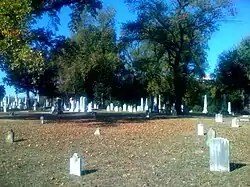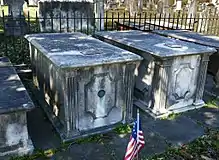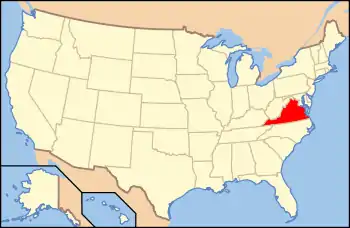Shockoe Hill Cemetery
The Shockoe Hill Cemetery is a historic cemetery located on Shockoe Hill in Richmond, Virginia.
Shockoe Hill Cemetery | |
 | |
  | |
| Location | Jct. of Hospital and 2nd Sts., Richmond, Virginia |
|---|---|
| Coordinates | 37°33′5″N 77°25′56″W |
| Area | 13 acres (5.3 ha) |
| Built | 1820 |
| Architect | Davies, John W.; et al. |
| Architectural style | Late Victorian, Early Republic, 19th-century Exotic Revival |
| NRHP reference No. | 95000818 [1] |
| VLR No. | 127-0389 |
| Significant dates | |
| Added to NRHP | July 7, 1995 |
| Designated VLR | April 28, 1995[2] |
History
Shockoe Hill Cemetery, as it is presently called, was established in 1820, with the initial burial made in 1822. It was earlier known as the "New Burying Ground" or "Shockoe Hill Burying Ground". This cemetery was the first to be entirely planned, opened, and operated using detailed record-keeping, by the City of Richmond. (The older St. John's Church Cemetery was operated in part by the City as a municipal burying ground, as were the Burial Ground for Negroes (Richmond's "1st African Burial Ground" in Shockoe Bottom), and the "Shockoe Hill African Burial Ground" or "Second African Burial Ground" -- see below). Shockoe Hill Cemetery expanded in 1833, in 1850, and in 1870, when it reached its present size of 12.7 acres.
Among many notables interred at the Shockoe Hill Cemetery are Chief Justice John Marshall, Unionist spymaster Elizabeth Van Lew, Revolutionary War hero Peter Francisco, and Virginia Governor William H. Cabell. More than thirteen hundred servicemen are known to be buried here, including at least 22 Revolutionary War veterans; at least 400 War of 1812 veterans; and an estimated 800 Civil War soldiers, both veterans and wartime casualties. Members of the General Society of the War of 1812 have suggested that more veterans of that War are buried at Shockoe Hill, than at any other cemetery in the country. More than 500 Union Army prisoners of war had been buried in Shockoe Hill Cemetery's adjoining African Burying Ground during the Civil War, but the soldiers remains were moved in 1866 to Richmond National Cemetery, three miles to the east.[3] Two markers, one placed by the United Daughters of the Confederacy in 1938, and the other by the Military Order of the Loyal Legion of the United States (a/k/a MOLLUS) in 2002, memorialize those POW burials.[4]
The Cemetery is open to burials of family members in existing family plots; the last such burial occurred in 2003. In July 2016 the City reclaimed title to several unused plots, on one of which there are plans to install a columbarium with niches to hold urns with cremated remains. Those plots (and eventually, niches) are available for purchase by the general public, marking the first sale of grave spaces in the Cemetery since about 1900. Shockoe Hill Cemetery is across Hospital Street from the Hebrew Cemetery of Richmond, a separate and privately-owned cemetery.
Shockoe Hill Cemetery is on the Virginia Landmarks Register and National Register of Historic Places. The City still owns and maintains the cemetery. The Friends of Shockoe Hill Cemetery,[5] a volunteer group formed in 2006, acts as a steward of the cemetery and assist with upkeep and improvement, including organizing the placement of government-issue military markers.
A 28 1/2-acre parcel, on part of which the Cemetery was established, had been acquired by the city in 1799 for the main purpose of creating burial grounds. It sat near to the City Poor-house, well outside the center core of the City. The parcel was divided to contain the walled Shockoe Hill Cemetery, and also a burial place for Richmonders of color, a short distance to the east, on the northeast corner of 5th and Hospital streets, where burials began in 1816. This burial ground was originally composed of two adjacent one-acre plots, the "Burying Ground for Free People of Colour" and the "Burying Ground for Negroes" (Slaves). Taken together, this ground for people of African descent was also greatly expanded over the following fifty years. The 1835 Plan of the City of Richmond shows an expansion of at least an acre to the slave burying ground. In 1850 when the city added 5 acres to the walled Shockoe Hill Cemetery, it also added 9 acres to what would come to be labeled on the 1853 Map of the County of Henrico as the "African Burying Ground", and included the City Hospital grounds. An 1816 plan of the city property also depicts the areas in which people of colour and white persons who died at the Poor-house were interred.
This now-invisible "Shockoe Hill African Burying Ground",[6] functioned as a segregated adjunct to Shockoe Hill Cemetery until it was closed to burials in 1879. Its grounds eventually were disposed of by the city, some of which became part of the Hebrew Cemetery. This burying ground is today also referred to by some as the "2nd African Burial Ground" or "second African Burying Ground"[7] and "African Burial Ground II". It has suffered numerous atrocities over time, and to this day continues to be threatened.[8] It does not share the historical designations of Shockoe Hill Cemetery.
Notable burials

The cemetery holds the graves of Chief Justice John Marshall;[9] attorney John Wickham (counsel for Aaron Burr in Burr's 1807 treason trial); Revolutionary War hero Peter Francisco; famed Union spy Elizabeth Van Lew, as well as many members of her spy network; John Minor Botts, a Congressman and later a dedicated Unionist who helped lead opposition to the Confederate government; Virginia Governor William H. Cabell; acting Virginia governors John Mercer Patton (General George S. Patton's great-grandfather), John Rutherfoord, and John Munford Gregory; Judge Dabney Carr; United States Senators Powhatan Ellis and Benjamin W. Leigh; Dr. Daniel Norborne Norton, developer of the Norton grape; more than twenty Revolutionary War veterans; and hundreds of Confederate soldiers. It is believed the more than 400 veterans of the War of 1812 buried here is the largest such assemblage in the country.
Many people important in the life of Edgar Allan Poe, who grew up and lived much of his adult life in Richmond, are interred at Shockoe Hill. Among them are Frances K. Allan, beloved foster-mother to Poe, and her husband John; Sarah Elmira Royster Shelton, perhaps the great love of Poe's life; and Jane Stith Craig Stanard, wife of prominent judge Robert Stanard, a warm friend to a teenaged Poe, and the inspiration for his poem "To Helen".[10] Poe is known to have visited the Cemetery many times in his life.
References
- "National Register Information System". National Register of Historic Places. National Park Service. March 13, 2009.
- "Virginia Landmarks Register". Virginia Department of Historic Resources. Retrieved 19 March 2013.
- "Roll of Honor: Names of Soldiers who Died in Defense of the American Union, interred in the National [and other] cemeteries" by United States, Quartermaster's Dept, Published by, Government Printing Office, Washington DC, 1865
- Burden, Jeffry. "The Union Soldiers of Shockoe Hill". The Union Soldiers of Shockoe Hill. Retrieved Jun 19, 2020.
- "Friends of Shockoe Hill Cemetery – Commemorating the Past". Retrieved Jun 19, 2020.
- "second African Burying Ground". Mar 28, 2017. Retrieved Jun 19, 2020.
- Death and Rebirth in a Southern City: Richmond's Historic Cemeteries, by Ryan K. Smith, Johns Hopkins University Press, 2020
- Smith, Ryan K I"Disappearing The Enslaved: The Destruction and Recovery of Richmond's Second African Burial Ground", Buildings & Landscapes: Journal of the Vernacular Architecture Forum Vol. 27, No. 1 (Spring 2020), pp. 17-45, University of Minnesota Press.
- Rudd, A. Böhmer. Shockoe Hill Cemetery; Richmond, Virginia; Register of Interments (1960) in libraries (WorldCat catalog)
- Silverman, Kenneth. Edgar A. Poe: Mournful and Never-ending Remembrance. New York: Harper Perennial, 1991: 206 ISBN 0-06-092331-8
External links
| Wikimedia Commons has media related to Shockoe Hill Cemetery. |

